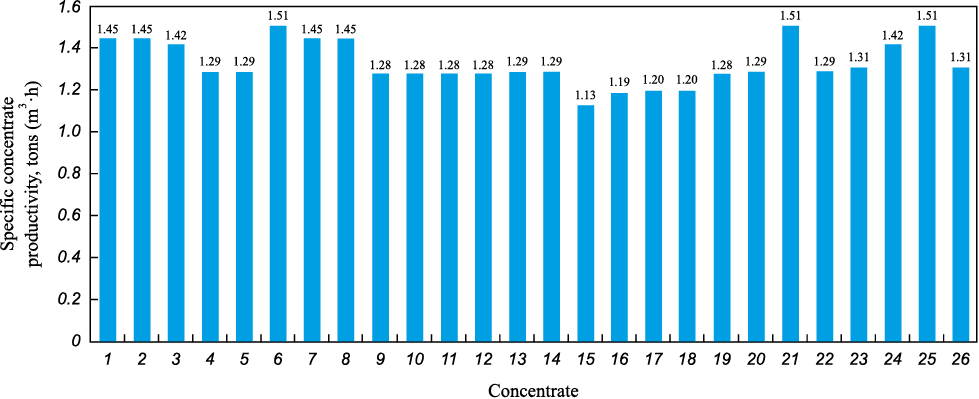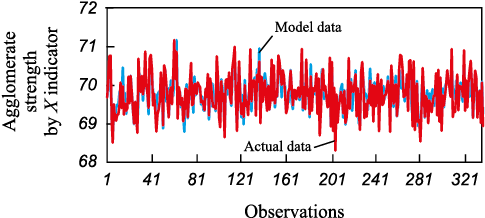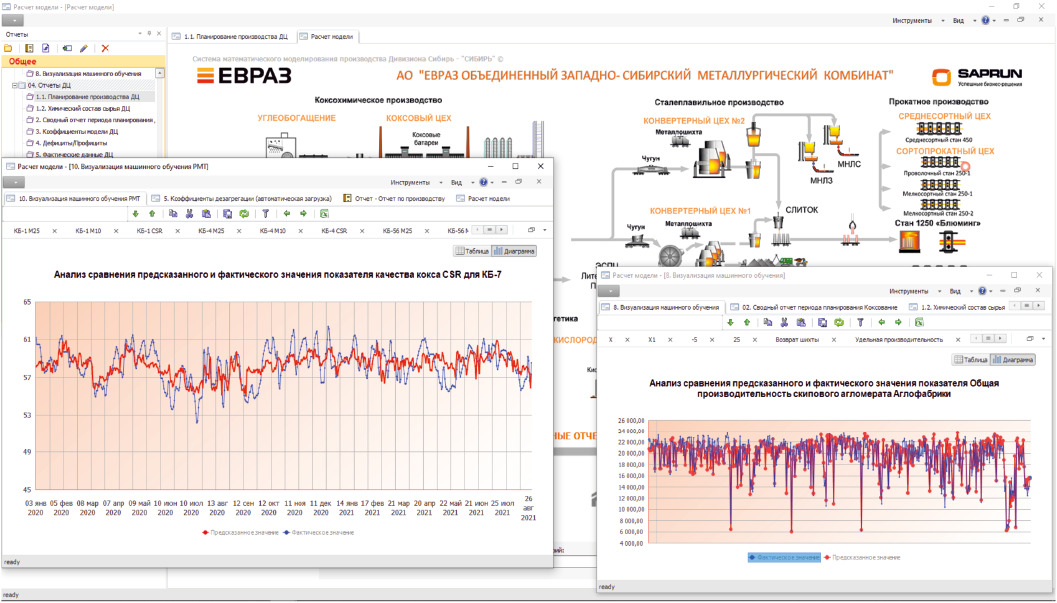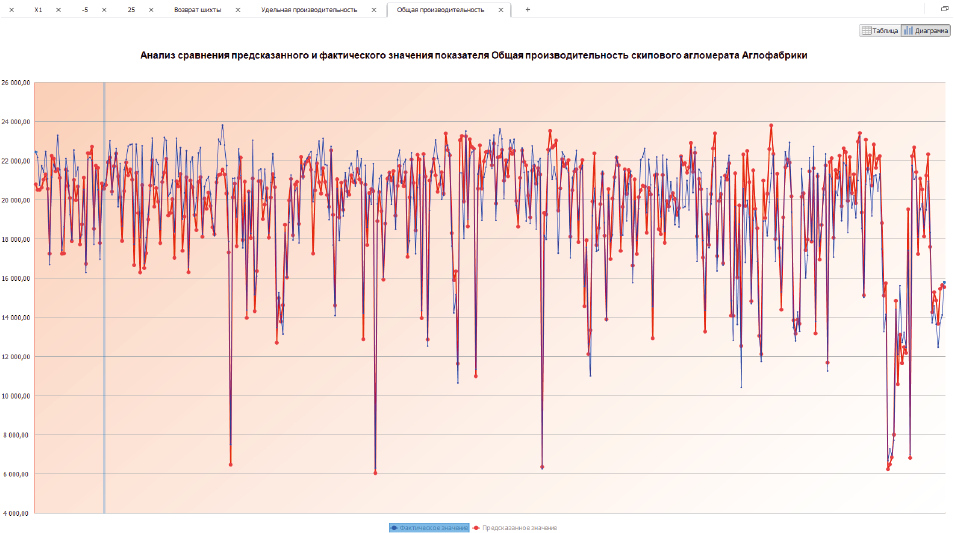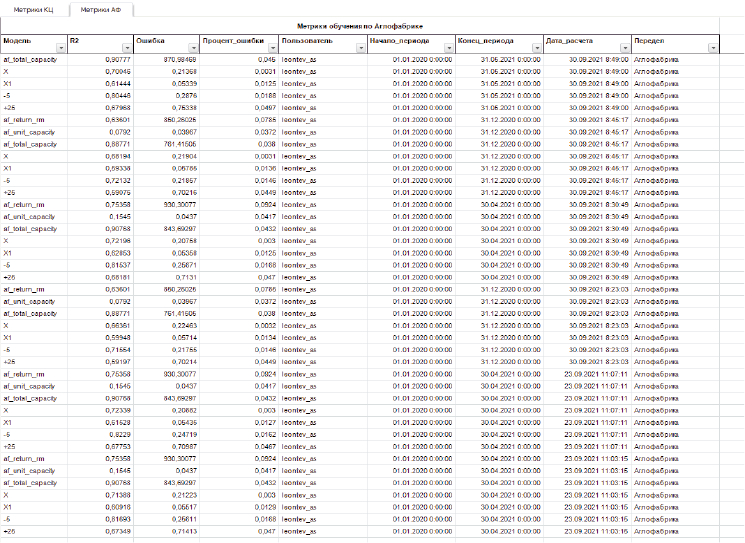Scroll to:
Experience in implementing machine learning to calculate the quality and production of agglomerate
https://doi.org/10.17073/0368-0797-2024-1-76-82
Abstract
In 2020, EVRAZ United West Siberian Metallurgical Combine JSC (EVRAZ ZSMK JSC) completed work on the creation of a mathematical modeling system for all processing units of the metallurgical plant. During testing of the system, a high error was found in the existing factor model for predicting agglomerate production, which was developed taking into account the specific sintering rate of individual concentrates. The paper proposes the use of linear regression to predict the productivity of sintering machines, which, unlike nonlinear methods, is optimal for integration into high-performance optimization systems. A feature of the work is forecasting, taking into account the proportion of the agglomeration charge. The model was tested at EVRAZ ZSMK JSC and showed sufficient accuracy (R2 > 90). A large economic effect is expected from the model. A separate study of existing agglomerate quality forecasting systems was conducted. Machine learning (ML) methods have recently made a great contribution to the development of forecasting models used to assess the quality of the agglomerate. This is due to the fact that the sintering process is a very complex dynamic with non‒linearity and a large delay. The physico-chemical phenomena involved in this process are complex and numerous. The neural network can constantly adjust the parameters of the model to reflect changes in systemic causes. A linear method was also studied to predict the agglomerate quality. Due to the poor quality of the resulting linear model, the “random forest” machine learning method was applied. Currently, the model is being operated as part of the integrated optimization program SMM Prognoz for the entire plant. For the convenience of the user, when implementing the module, visualization of the model quality using historical data was added, as well as the statistical metrics obtained.
For citations:
Leont’ev A.S., Rybenko I.A. Experience in implementing machine learning to calculate the quality and production of agglomerate. Izvestiya. Ferrous Metallurgy. 2024;67(1):76-82. https://doi.org/10.17073/0368-0797-2024-1-76-82
Introduction
Presently, the primary manufacturers of steel are integrated full-cycle enterprises that function utilizing the sintering and blast furnace methodology [1]. The reduction process of iron, which facilitates the production of cast iron, is executed within blast furnaces. This is followed by the oxidation of impurities, which occurs in converters and electric furnaces, with further refinement conducted outside of the furnace [2].
It is established that for the production of cast iron in blast furnaces, agglomerates, pellets, and briquettes are utilized. Concurrently, the necessity to process fine ore and concentrate into larger aggregates is underscored, as their application in blast furnace smelting is pivotal for ensuring high gas permeability of the layer – a critical condition for the efficient operation of the blast furnace [3]. Among the trio of sintering methods – briquetting, agglomeration, and pelletizing – agglomeration emerges as the prevalent choice, presenting several notable benefits over the alternatives. Notably, agglomeration facilitates the integration of by-products and in-house waste (such as sludge, blast furnace dust, etc.) into the production cycle [4]. This incorporation aids in moisture retention and contributes to the diminution of harmful emissions into the atmosphere, thereby enhancing environmental sustainability.
Market analysis over the past five years has highlighted the significance of augmenting agglomerate production, primarily due to the cost-effectiveness of producing agglomerate from purchased concentrate in comparison to the acquisition costs of pellets. Generating an additional ton of agglomerate yields financial benefits for the enterprise through the substitution of the more expensive pellets, which are subject to limitations regarding their maximum proportion within the agglomeration charge. This limitation is attributed to the “swelling” phenomenon observed in pellets during the reduction process [5]. For instance, at EVRAZ United West Siberian Metallurgical Combine JSC (EVRAZ ZSMK JSC), the pellet proportion should not surpass 30 %. Therefore, to optimize cast iron production, merely procuring pellets is insufficient; there is a clear necessity to escalate the production of agglomerate.
The enhancement of agglomerate production is facilitated through several strategies [6]:
– expansion of agglomerate production capacity (extensive way);
– amplification of the sintering process efficiency (intensive way);
– improvement of the yield quality, achieved through enhancements in agglomerate quality, including the reduction of fines production;
– employment of sub-standard agglomerate in blast furnace smelting (compromise).
The optimization of the charge composition during sintering crucial for enhancing the quality of agglomerate and the efficiency of sintering machines, potentially increasing the enterprise’s profit margins at no extra cost [7 – 11].
This article presents the outcomes of mathematical modeling and optimization of the aglocharge forming process under the specific conditions at EVRAZ ZSMK JSC.
Data collection
For the purposes of this research, two distinct datasets were obtained from the operations of the sinter plant at EVRAZ ZSMK JSC. The initial dataset spans from 2018 to 2021, providing a detailed, shift-by-shift analysis of all relevant technical parameters for each of the three sintering machines. This includes data on operating time, pressure differential, temperature in the hearth, total material consumption measured by the main scales, layer height, as well as the volume and quality of the agglomerate produced, return volumes, among other technical metrics. The process of data collection for this dataset is fully automated and the information is stored within MSSQL databases.
The second dataset required the assembly of data concerning the consumption volumes of concentrates, fluxes, and fuels for each sintering machine, broken down on a daily basis. Initially, this data was manually collected and recorded in Excel files. However, during the preparation of this article, the data collection process was automated, with information systematically transferred to a database by recording the item numbers of materials and their respective consumption volumes.
The culmination of this effort resulted in a comprehensive dataset comprising raw, unprocessed data.
Data processing
The data was subjected to a day-by-day analysis under specific criteria:
– the volume of consumed fuel must not equal zero;
– the volume of produced agglomerate must not equal zero;
– the volume of returns must not exceed the volume of agglomerate produced.
Observations failing to meet any of these criteria were excluded. Except for consumed coke volume and agglomerate production, all indicators were set to zero in cases of missing data, treating such absences as zeroes.
Furthermore, to analyze model behavior with aggregated data, monthly dynamics indicators were derived from the dataset.
Given that the charge is not individually supplied to each sintering machine and is considered uniformly distributed, a proportional allocation of charge consumption and agglomerate production volumes was employed for individual machine analysis, based on data from the main scales at EVRAZ ZSMK JSC.
Rationale for developing a mathematical model of the agglomerate production process
The enhancement of agglomerate production can be achieved through the construction of new facilities or the implementation of technical advancements, such as [4]:
− the application of lime and lime milk (hydrate Ca(OH)2 , produced by CaO reacting with water) which exhibit strong binding qualities, significantly boosting the granulation speed of the charge and the robustness of the resulting granules. This enhancement in turn improves the gas permeability of the sintered charge layer, leading to increased efficiency of the sintering machines;
− preheating the charge, typically with hot return and steam, is crucial especially when sintering finely ground concentrates to prepare the charge for sintering by preheating, thus preventing granule disintegration due to over-moistening;
− elevating the depression in the gas manifold, which augments the rate of fuel combustion and the vertical speed of sintering;
− diminishing the basicity of the agglomerate through a reduction in the consumption of fluxes such as lime, dolomite, and limestone.
The sintering process at EVRAZ ZSMK JSC is influenced by a variety of factors, some of which may conflict with one another. For instance, an increase in lime content can enhance production by 1.0 – 3.5 %, yet concurrently, it elevates the basicity of the agglomerate, adversely impacting productivity.
Factors of agglomerate production intensification
| |||||||||||||||||||||||||||||||||||||||||||||||||||||
Furthermore, the specific productivity of sintering machines is affected differently by various concentrates. To refine the accuracy of the charge planning process, experimental sintering involving diverse concentrates was conducted, with the specific productivity assessed. The anonymized results, in compliance with commercial confidentiality requirements, are illustrated in Fig. 1. It was observed that productivity rates for sintering machines fluctuate markedly across different concentrates. From the test outcomes, a model for estimating charge productivity was formulated, delivering satisfactory performance. However, due to the substantial expense associated with the process (the cost of pilot sintering can approach 1 million rubles), these experiments have not been replicated nor the coefficients reevaluated for over a decade. A universal correction factor was incorporated into the model to facilitate its validation.
Fig. 1. Specific productivity of various concentrates at EVRAZ ZSMK JSC |
The variability in component composition of concentrates, as well as in the composition of fuel, fluxes, and the basicity and chemical composition of the produced agglomerate, during operations at sintering plants indicates that the specific productivity of concentrates alone is not adequate for accurately calculating the productivity of sintering machines. Simply revising the coefficients does not suffice to achieve the necessary precision in the model.
Consequently, the comprehensive assessment of the impact of all these factors on the productivity of sinter machines and the quality of agglomerate can only be accurately conducted through the application of machine learning techniques, utilizing archival data.
The review of literature [12 – 17] confirms the extensive application of machine learning not only in evaluating the quality of agglomerate but also in forecasting its production.
In 2021, EVRAZ ZSMK JSC initiated a project aimed at developing a mathematical model to evaluate the productivity of its sintering machines.
Defining objectives for applying machine learning
The regression mathematical model for calculating the productivity of the sinter plant is as follows:
| y = b0 + b1 x1 + b2 x2 + ... + bn xn , | (1) |
where y the predicted volume of bin agglomerate, tonn; b0 is the intercept; b1 , b2 , bn are the regression coefficients corresponding to the factors; and x1 , x2 , xn are the factors influencing the volume of bin agglomerate.
The objective of this project is to refine a mathematical model through the training on historical data concerning concentrate consumption and sinter machine productivity, aiming to:
– enhance the precision of mathematical modeling;
– increase confidence in the system by allowing users to verify results against archived data;
– identify new charging modes for the charge to optimize agglomerate production.
The system prototype operates in a “Train the model” mode, performing the following functions:
− loading the specified period of sintering data;
– training a performance model utilizing the archived data;
− training a quality model based on the data;
− presenting a table/graph of actual versus predicted data;
− displaying model quality indicators, such as (R2).
Upon completion, the program notifies the user that the task is finished, detailing the outcomes of the most recent model training.
Users should also have the capability to toggle between different graphs to evaluate the model’s accuracy on various metrics (actual/forecast), including agglomerate quality, sieve quantity, bin agglomerate, and skip agglomerate.
The input data for the model encompassed the following indicators:
− consumed concentrates clarification;
− volume of consumed concentrates, tonn;
− consumption of fluxes (limestone, dolomite, lime, brucite), tonn;
− fuel consumption;
− agglomerate strength;
− chemical composition of agglomerate (content of Fe, CaO, SiO2 , basicity);
− sintering machine process parameters (layer height, depression in the header);
− volume of agglomerate production.
Forecasting agglomerate quality
The Random forest method was employed for predicting agglomerate quality, given its superior forecasting accuracy compared to regression analysis. The Random Forest algorithm, developed by Leo Breiman and Adele Cutler, is a machine learning approach that employs an ensemble of decision trees. It integrates the Breiman Bagging method with the random subspace method introduced by Tin Kam Ho, making it versatile for classification, regression, and clustering tasks. The strength of this algorithm lies in its utilization of a large number of decision trees, each individually contributing to low classification accuracy. However, when aggregated, these trees produce significantly improved results [18]. Fig. 2 illustrates the correlation between actual agglomerate quality and the outcomes estimated by the model. With a coefficient of determination at 60 %, the model’s adequacy is affirmed, as the benchmark for the coefficient of determination is set at a minimum of 50 % [19].
Fig. 2. Comparative analysis of model and actual data |
This approach forms part of a comprehensive model that encapsulates both technical and economic aspects, delineating the interplay between chemical, thermodynamic, mechanical processes, and productivity, alongside considerations for product availability and logistics costs.
A notable characteristic of the Prognoz system is its capability to seamlessly incorporate third-party software modules into its computations. A screenshot presented in Fig. 3 displays the user interface of the Prognoz system in operation.
Fig. 3. Working window of the SMM system Prognoz |
To enhance user experience, functionalities for visualizing the quality of the model were introduced alongside the module implementation (Fig. 4). Post-training, users have the facility to visually assess the training outcomes. Additionally, there’s provision to review the history of model training, enabling users to select the optimal period for further training based on specific metrics (Fig. 5).
Fig. 4. Visualization of the learning quality of the model
Fig. 5. History of calculations and metrics |
Conclusions
Throughout this project, archival data from the sinter plant of EVRAZ ZSMK JSC was meticulously gathered and analyzed. Utilizing statistical methodologies, the study identified and quantified the relationships between various input factors – such as the consumption rates of charge components, operational technical parameters of the sinter machines, and the chemical composition of the agglomerate – and the resulting productivity and quality of the agglomerate. Both linear and nonlinear correlations were discovered, with the proportions of charge component consumption being highlighted as having a significant impact on forecasting accuracy. These insights were subsequently incorporated into the forecasting module of the SMM mathematical modeling system, Prognoz, developed for EVRAZ ZSMK JSC.
References
1. Lisienko V.G., Solov’eva N.V., Trofimova O.G. Alternative Metallurgy: Problem of Alloying, Model Efficiency Estimates. Moscow: Teplotekhnik; 2007:440. (In Russ.).
2. Protopopov E.V., Kalinogorskii A.N., Ganzer A.A. Steel-making production: Current state and directions of development. In: Metallurgy: Technologies, Innovations, Quality. Proceedings of the XX Int. Sci. and Pract. Conf. Part 1. Novokuznetsk: SibSIU; 2019:9–14. (In Russ.).
3. Spirin N.A., Ovchinnikov Yu.N., Shvydkii V.S., Yaroshenko Yu.G. Heat Exchange and Efficiency Improvement of Blast Furnace Smelting. Yekaterinburg: USTU; 1995:243. (In Russ.).
4. Frolov Yu.A. Agglomeration. Technology, Heat Engineering. Moscow: Metallurgiya; 2006:600. (In Russ.).
5. Geerdes M. Modern Domain Process. Moscow: Metallurgizdat; 2016:273. (In Russ.).
6. Bizhanov A., Chizhikova V. Agglomeration in Metallurgy. Springer; 2020:453. http://doi.org/10.1007/978-3-030-26025-5
7. Rybenko I.A. Solving a task of metallurgical processes optimization by using instrumental system “Engineering-Metallurgy”. Ferrous Metallurgy. Bulletin of Scientific, Technical and Economic Information. 2018;1(3):42–47.(In Russ.).
8. Rybenko I.A. Development of optimal technological modes of metal production processes using mathematic modelling methods and instrumental system. Ferrous Metallurgy. Bulletin of Scientific, Technical and Economic Information. 2018;1(2):57–61. (In Russ.).
9. Mitterlehner J., Loeffler G., Winter F., Hofbauer H., Schmid H., Zwittag E., Buergler T.H., Pammer O., Stiasny H. Modeling and simulation of heat front propagation in the iron ore sintering process. ISIJ International. 2004;44(1):11–20. http://doi.org/10.2355/isijinternational.44.11
10. Yang W., Rui C., Choi S., Choi E., Lee D., Huh W. Modeling
11. of combustion and heat transfer in an iron ore sintering bed with considerations of multiple solid phases. ISIJ International. 2004;44(3):492–499. http://doi.org/10.2355/isijinternational.44.492
12. Fernandez-Gonzalez D., Martin-Duarte R., Ruiz-Bustinza I., González-Gasca С., Verdeja L.F. Optimization of sinter plant operating conditions using advanced multivariate statistics: Intelligent data processing. JOM. 2016;68:2089–2095. http://doi.org/10.1007/s11837-016-2002-2
13. Silva T.P., da Silva A.M., Resende B.A., da Silva B.V. Prediction of sinter plant productivity by neural network. In: 6th Int. Congress on the Science and Technology of Ironmaking. 2012;6(6):764–776.
14. Mohanan S., Mohapatra P., Kumar C.A., Adepu R.K., Koranne V.M., Prasad Y.G.S., Reddy A.S., Ramna R.V. Prediction and optimization of internal return fines generation in iron ore sintering using machine learning. Advances in Materials. 2021;10(3):42–46. http://doi.org/10.11648/j.am.20211003.12
15. Mochón J., Ruiz-Bustinza I., Cores A., Verdeja L., Robla J.I., Garcia-Carcedo F. Iron ore sintering. Part 2. Quality indices and productivity. In: DYNA. 2014;81(183):168–177. http://doi.org/10.15446/dyna.v81n183.41568
16. Shao H., Yi Z., Chen Z., Zhou Z., Deng Z. Application of artificial neural networks for prediction of sinter quality based on process parameters control. Transactions of the Institute of Measurement and Control. 2019;42(3):422–429. https://doi.org/10.1177/0142331219883501
17. Mallick A., Dhara S., Rath S. Application of machine learning algorithms for prediction of sinter machine productivity. Machine Learning with Applications. 2021;6:100186. https://doi.org/10.1016/j.mlwa.2021.100186
18. Song L., Qing L., Xiaojie L., Yanqin S. Synthetically predicting the quality index of sinter using machine learning model. Ironmaking & Steelmaking Processes, Products and Applications. 2020;47(7):828–836. http://doi.org/10.1080/03019233.2019.1617573
19. Random Forrest. WIKIPEDIA. Available at URL: https://ru.wikipedia.org/wiki/Random_forest (Accessed 05.01.2024).
20. Coefficient of Determination. WIKIPEDIA. Available at URL: https://ru.wikipedia.org/wiki/Коэффициент_детерминации (Accessed 05.01.2024).
21. Leont’ev A.S., Rybenko I.A., Borisov A.S., Volkova I.V. Experience in development and application of a mathematical modeling system at EVRAZ ZSMK JSC. In: Modeling and High-Tech Information Technologies in Technical and Socio-Economic Systems. Proceedings of the V All-Russ. Sci. and Pract. Conf. with Int. Participation. Novokuznetsk: SibSIU;2021:250–255. (In Russ).
About the Authors
A. S. Leont’evRussian Federation
Aleksei S. Leont’ev, Postgraduate of the Chair of Applied Information Technologies and Programming
42 Kirova Str., Novokuznetsk, Kemerovo Region – Kuzbass 654007, Russian Federation
I. A. Rybenko
Russian Federation
Inna A. Rybenko, Dr. Sci. (Eng.), Assist. Prof., Head of the Chair of Applied Information Technologies and Programming
42 Kirova Str., Novokuznetsk, Kemerovo Region – Kuzbass 654007, Russian Federation
Review
For citations:
Leont’ev A.S., Rybenko I.A. Experience in implementing machine learning to calculate the quality and production of agglomerate. Izvestiya. Ferrous Metallurgy. 2024;67(1):76-82. https://doi.org/10.17073/0368-0797-2024-1-76-82



